Electric radiators. advantages and disadvantages. varieties
Currently, for heating residential apartments and private houses in the cold season, the most often used is a closed-circuit water heating system through which the heated coolant constantly circulates. This scheme is quite reliable and economical, and in addition allows you to easily maintain the desired temperature in the room for a long time.
At the same time, this option is the most difficult, since its use requires a direct connection to the central heating system, and in the case of autonomous residence, a prerequisite is bringing natural gas into the house, and installing special boiler equipment.

Electric Battery Overview
As a worthy alternative to water, gas and stove heating, you can consider electric heating batteries that can be used during the cold season, both for heating a residential apartment and for heating a country house of permanent or seasonal residence.
In order to study this issue in more detail, this article will present a comparative review of the most common types of household electric heaters, which describes their main technical characteristics, as well as the main advantages and disadvantages.
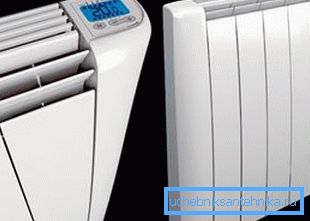
Advantages and disadvantages of electric heating
There is a widespread opinion that when using electric heaters as the main heating system, the main significant drawback of this scheme is the relatively high cost of operating electric heaters, since for full heating of a residential house it is necessary to use appliances with high power consumption.
At the same time, energy consumption can be significantly reduced if, during the construction process, proper insulation of the roof, floors, and the exterior walls of the building is carried out, and energy efficient technologies are used in arranging window and door openings.

Otherwise, the use of electric heaters has a number of indisputable advantages over water, stove or gas heating.
- To install an electric heating system, it is not necessary to connect the gas pipeline and connect to the centralized steam heating system., and in addition, no additional room is needed for the installation of complex and expensive boiler equipment.
- Household electric heaters are connected to a single-phase AC mains, voltage of 220 volts, which is available in every residential building.
- Installation of such a system is easy to do by hand. without the help of gas, stove, welders and professional plumbers.
- To connect the battery is used only a power cable of suitable cross section., while for the installation of water heating it is necessary to purchase a large number of pipes, as well as the use of energy-intensive welding equipment.
- In case of repair work in the system, or winter conservation of the building, there is no need to completely drain the coolant, and subsequent filling of the system, upon completion of the repair work.
- Annual scheduled maintenance is the periodic cleaning of the finned surfaces of the heat exchanger from dust and small household garbage.

Tip! When summing up the input power cable to a residential house, in addition to the power of all household electricity consumers, it is necessary to take into account the total power consumption of all electric radiators.
Varieties of electric heaters
Taking into account the wide variety of modern heating devices, all domestic electric heating batteries can be divided into several groups, which differ in the design and the principle of transfer of thermal energy into the surrounding space.
- Oil heaters have a high heat capacity and are able to maintain a given temperature in the room for a long time.
- Convectors contribute to the constant movement of heated air masses throughout the room, which transfer heat to surrounding objects.
- Infrared heaters emit electromagnetic waves of a narrow frequency spectrum, which transmit thermal energy to surrounding objects.

Note! For short-term and fast heating of the room, the use of electric fan heaters is also effective, however, due to economic inexpediency, and non-compliance with the requirements of SanPiN, they are not recommended to be used as main heating devices.
Oil radiators
By the principle of heat transfer, oil radiators are most of all similar to conventional steam heating batteries. Structurally, any oil electric heating battery is a hermetically sealed container, inside which there is a special oil having a high boiling point, which makes these devices absolutely safe from the point of view of destruction from steam impact. In the lower part of the oil radiator, the heating element is installed (tubular electric heater), which is constantly immersed in the oil bath during operation.
After turning on the heating element, the heated oil is gradually distributed over the entire volume of the radiator, evenly transferring heat to its outer surface and, accordingly, to the surrounding air. The system controls the electronic or mechanical thermostat, which allows you to maintain the desired temperature throughout the entire period of operation of the radiator.
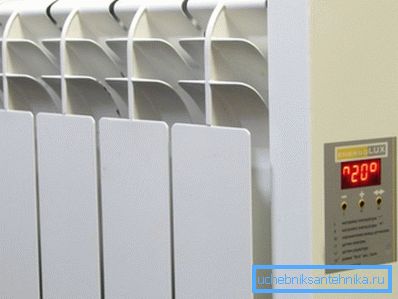
The following technical characteristics can be attributed to the positive qualities of such devices:
- High level of security, as well as reliability and durability of the device for a long period of operation.
- The absence of open heating elements does not dry the air, does not contribute to the combustion of oxygen, as well as the combustion of small dust particles, which ensures a normal microclimate in the room.
- The high heat capacity of the oil allows you to retain heat for a long time, and give it to the room when the heating element is turned off, thereby reducing the specific consumption of electricity consumed.
- The simultaneous combination of convective and radiant type of transfer of thermal energy, significantly increases the efficiency of this device, compared with other types of household heaters.
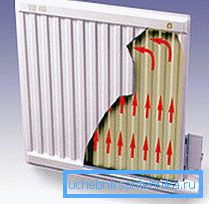
Tip! Oil radiators with the same intensity radiate heat in all directions, therefore, for maximum heat transfer, they are not recommended to be installed behind pieces of furniture, as well as in niches, walls, and other places with limited space.
Electric convectors
Convective-type heaters are a closed box-shaped structure made of sheet steel or aluminum, inside of which a heating element is installed. In the lower part of the body are slotted holes for the entry of cold air, and in the upper part - the same holes for the exit of heated air.
After switching on the heating element, the air inside the closed case heats up, rushes up, and out through the upper slit holes. A small vacuum is created inside the case, therefore, to replace the heated air, cooled air flows in through the lower slit holes, which, when heated, also rushes up.
Thus, a natural circulation of air masses in the room is created, which, replacing each other, pass through the heating element, and are gradually heated to the desired temperature.

Among the main distinguishing features of electric convectors, the following consumer qualities can be distinguished.
- A large selection of models with different power consumption makes it possible to choose the right device for any size of heated space.
- Rapid heating of the room and high efficiency allows using such devices both as a primary and as an auxiliary heating system.
- The absence of external strongly heated parts, small overall dimensions, and aesthetic appearance make it possible to install such devices without any additional protective and decorative finish.
- An open heating element is more susceptible to wear than a closed one, and its efficiency decreases with time, therefore, the instruction manual for convectors requires its periodic replacement.
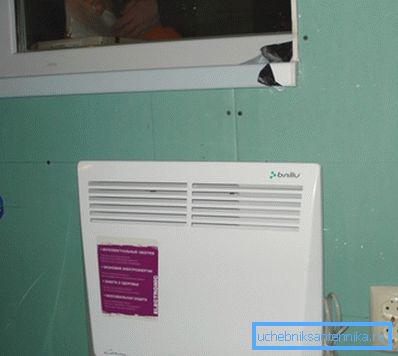
Tip! Given the specifics of this device, it is best to install it under the window sill so that its lower edge is at a height of 50 to 150 mm from the floor. Thus, a natural thermal curtain is created, which allows cutting off the cooled air moving from the window.
Infrared heaters
This type of household electric heaters is fundamentally different from what everyone used to call an electric radiator, both in appearance and in the principle of transfer of thermal energy. In the process, it does not heat the surrounding air, and its action is based on the emission of high-frequency waves of the infrared spectrum, which cause heating of the surrounding objects.
In turn, according to the principle of the radiator, all such devices are also divided into several types:
- High-temperature radiators are a tube made of heat-resistant quartz glass, with an electric spiral or a halogen lamp inside, which heats up to a very high temperature. A deflector made of polished aluminum or stainless steel is mounted on the back of the tube, which reflects and directs the entire radiation flux towards the room.
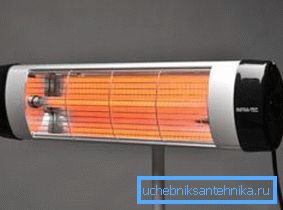
- Low-temperature heaters are made in the form of a thin panel of glass or ceramic materials, inside which are infrared emitters. The surface of the panel is heated to a temperature of no more than + 80 °, which allows it to be mounted on the walls or ceiling in the room.
- Film emitters are a thin flexible film of polymeric materials, on which a special semiconductor coating is applied. Due to its compact size, such a device can be built into furniture, or details of decorative interior decoration.
The main feature of all infrared emitters is that they can heat only those items that are in line of sight, therefore, to ensure full heating of housing, you need to correctly place the infrared emitters, taking into account the location of furniture, and other "dead zones" in the room .
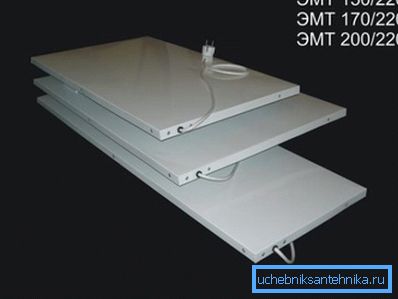
Conclusion
Finally, it should be noted that for the correct selection of household electric batteries, it is necessary, first of all, to calculate the total volume of each heated room and, based on this value, select the optimal power consumption of the heating device separately for each room.
Additional information on this issue can be obtained by watching the video at the end of this article, or by reading similar materials on our website.